
Learn about what they are, how they work and what you need to get up and running with them!
Originally appeared here:
Getting started with Vector Databases
Go Here to Read this Fast! Getting started with Vector Databases


Learn about what they are, how they work and what you need to get up and running with them!
Originally appeared here:
Getting started with Vector Databases
Go Here to Read this Fast! Getting started with Vector Databases


Is context from non-redundant nearest neighbors sufficient for LLM to generate accurate responses?
Originally appeared here:
Understanding Impact of Advanced Retrievers on RAG Behavior through Visualization


How the modern AI boom has completely revolutionized search applications…
Originally appeared here:
The Basics of AI-Powered (Vector) Search
Go Here to Read this Fast! The Basics of AI-Powered (Vector) Search


How I created custom GPTs for creative endeavors that draw from works in the public domain
Originally appeared here:
Creating OpenAI GPTs for (lots of) Fun and (a little) Profit
Go Here to Read this Fast! Creating OpenAI GPTs for (lots of) Fun and (a little) Profit
Future bio-AI breakthroughs will arise from novel high-throughput low-cost AI-specific “black-box” data modalities.
Originally appeared here:
The Road to Biology 2.0 Will Pass Through Black-Box Data
Go Here to Read this Fast! The Road to Biology 2.0 Will Pass Through Black-Box Data
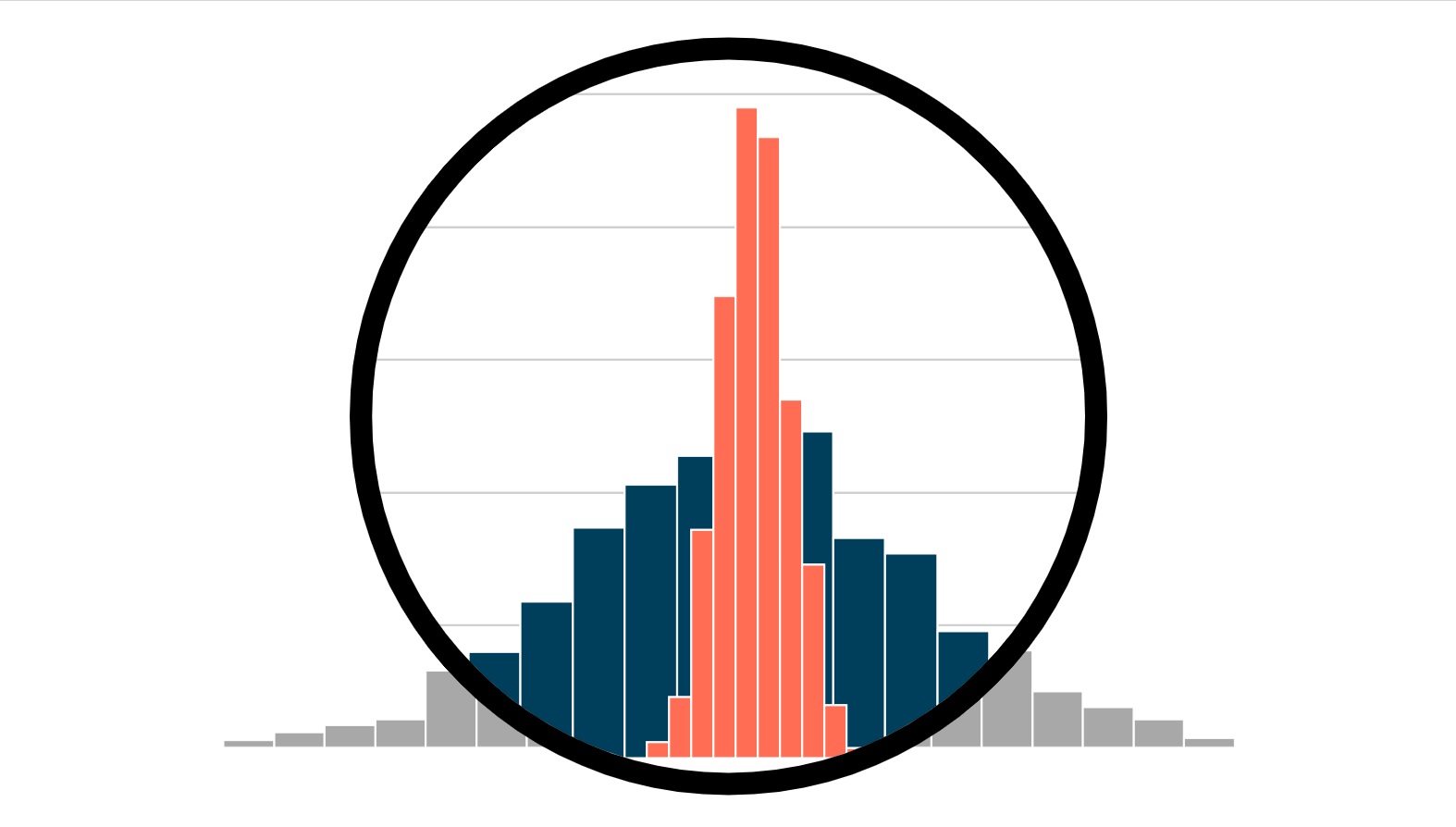
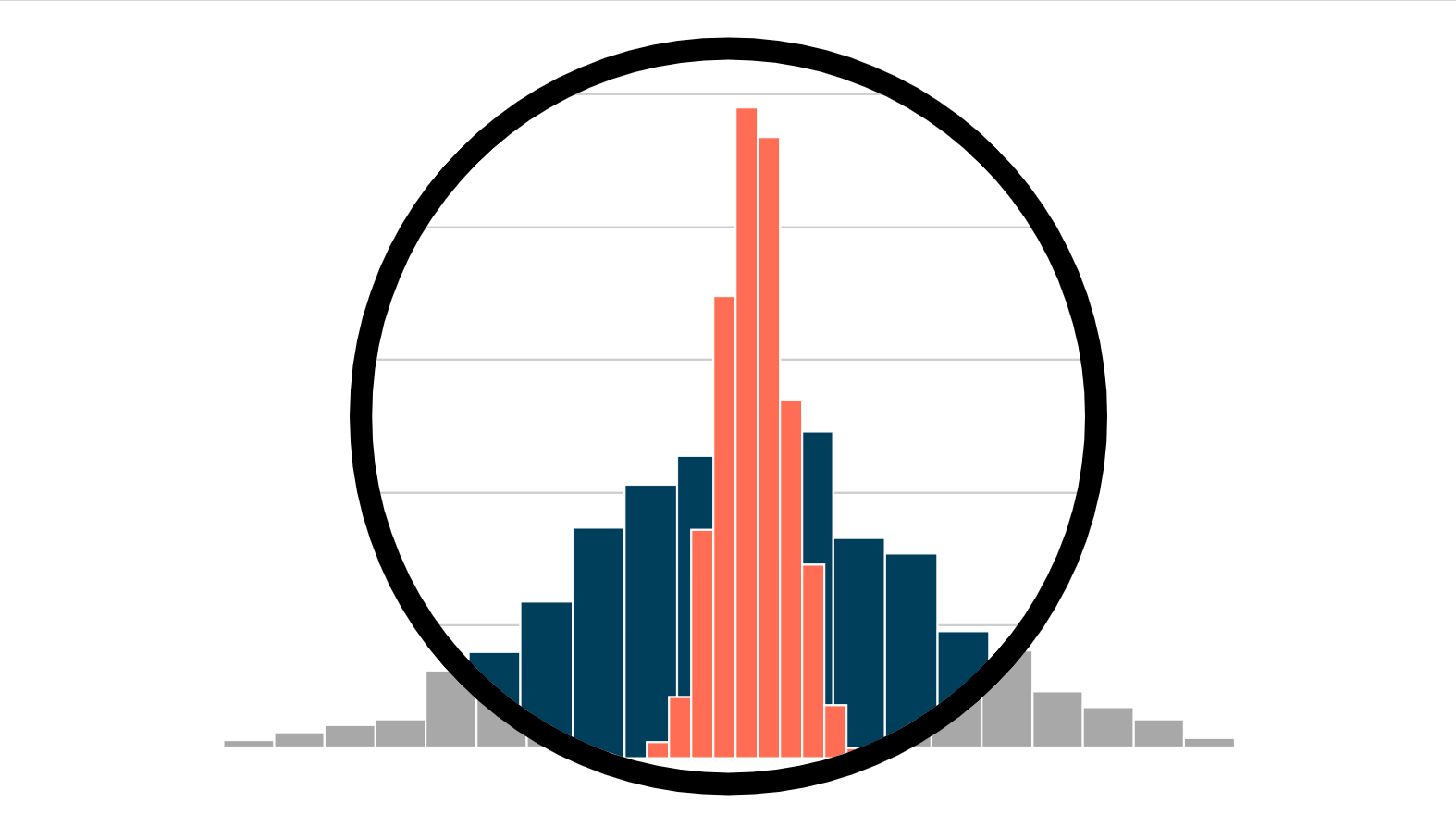
What to do when the unit of observation differs from the unit of randomization
Originally appeared here:
Clustered Standard Errors in AB Tests
Go Here to Read this Fast! Clustered Standard Errors in AB Tests
Outlining strategies and solution architectures to incrementally load data from various data sources.
Originally appeared here:
Data Engineering: Incremental Data Loading Strategies
Go Here to Read this Fast! Data Engineering: Incremental Data Loading Strategies


When considering dashboards, it’s evident that many people lack substantial experience using them. Particularly, stakeholders and clients without analytical or data-oriented backgrounds may be unfamiliar with newer tools and their functionalities. Consequently, this discrepancy creates a barrier between analysts and end users from using insights and solutions effectively.
Interestingly, stakeholders frequently show a preference for traditional Excel sheets, despite the threat of information overload. However, this dependence on spreadsheets can unintentionally exclude critical information amidst the sea of data.
As data and business analysts, we often encounter a pivotal question: How can we make our data more accessible? How can we condense comprehensive insights into bite-sized chunks without compromising their substance? Moreover, how can we encourage the adoption of dashboards over the utilization of raw data by stakeholders?
In my quest for solutions, I have found that dashboards with interactivity and user-friendliness are the keys to enhancing engagement. We can encourage engagement by transforming the dashboard into a convenient and inviting interface that resembles everyday websites or familiar tools.
Here are five techniques that I’ve found useful in making my dashboards interactive and compelling:
1. Designing a Collapsible Slicer Panel
One of the major challenges I encountered when working in Power BI was the challenge of maximizing the available space on the canvas. Slicers and filters are great for summarizing vast datasets and offering various avenues to analyze information, but they can also consume a significant amount of real estate. To address this issue, I explored different approaches. While using filters in the filter panel is one way, it’s not always the ideal solution from a stakeholder’s perspective. This approach often needs additional context about the source data and the filter configuration, unlike the straightforward click of a slicer button.
Creating collapsible slicer panels using a few Power BI tools can help maximize canvas space and enhance interactivity, contributing to a smoother workflow.

2. Inserting Interactivity into KPI Cards
One aspect I’ve discovered to be less effective in dashboard design is the tendency to include too many pages. The ultimate aim is to capture attention quickly within a limited timeframe. A more efficient approach involves categorizing similar data on one page. Key Performance Indicators (KPIs) play a crucial role in this strategy, providing succinct summaries at a glance. By associating visualizations with specific KPIs, we can dive deeper into the data and convey more comprehensive insights. This integration not only simplifies the user experience but also ensures that essential information is easily accessible by maximizing the dashboard’s effectiveness within the given timeframe.
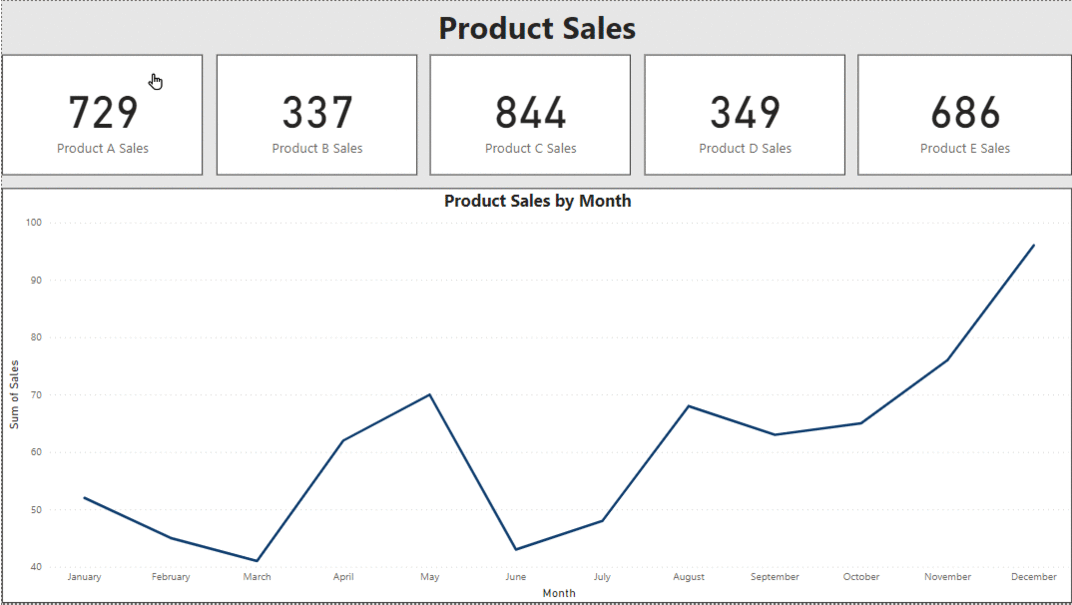
3. Using Bookmarks as Buttons
When a single dashboard is used by diverse consumer levels, the necessity arises to provide tailored views of the same data. A powerful solution for this problem is to utilize bookmarks. In Power BI, bookmarks serve as markers for specific data states, displays, and pages. They offer a customizable way to capture various functionalities, enabling users to group different bookmarks for seamless navigation using buttons or bookmark navigators. This functionality empowers dashboard creators to craft personalized experiences for users of all levels, ensuring that each consumer can access the insights most relevant to them with ease. Furthermore, it helps eliminate redundant visualizations that essentially convey the same insights across different data points.
4. Incorporating Drill-down and Drill-through Functionality
Data hierarchy allows users to seamlessly navigate through different levels of data, facilitating both drill-down and drill-through capabilities. By leveraging this feature, users can effortlessly transition between high-level summaries and detailed information to fit specific use cases. Power BI offers this functionality within its visualizations, allowing users to interact with data points organized in hierarchical structures. This simple yet powerful feature enhances the ability to answer business questions, providing users with the flexibility to explore insights at different levels of granularity with ease.

5. Page Navigation for a Website-like Feel
Power BI offers the flexibility of page navigators, enabling a seamless transition between different pages within the dashboard. By adding buttons on each page, users can navigate through the entire dashboard easily. This navigation not only enhances connectivity between different pages of the dashboard but also provides a convenient way to build a narrative across various sources of data within the dashboard. With the ability to tell a story and explore insights across multiple pages, Power BI helps users create dynamic and engaging data-driven experiences.
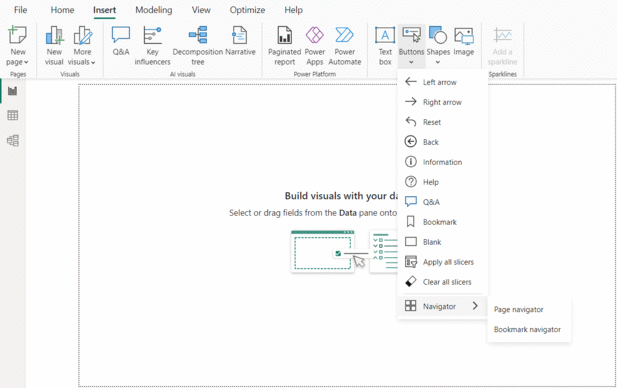
Dashboards represent a transformative tool in data visualization. Irrespective of your audience from different age groups or functional backgrounds, the creation of a user-friendly dashboard could potentially expand your outreach and connect a wider audience. These user-centric features have greatly helped me in my capacity to narrate captivating stories through data across different levels of my organization. Embrace the power of dashboards and embark on a journey of insightful storytelling.
For suggestions, questions, and all things data, let’s connect on Medium and LinkedIn.
Creating Interactive Power BI Dashboards That Engage Your Audience was originally published in Towards Data Science on Medium, where people are continuing the conversation by highlighting and responding to this story.
Originally appeared here:
Creating Interactive Power BI Dashboards That Engage Your Audience
Go Here to Read this Fast! Creating Interactive Power BI Dashboards That Engage Your Audience

There is nothing called Self join in SQL. Hear me out.
Often Data Analysts ad Data Engineers need to find patterns in data that are not obvious. Howevre the insights can be generated and patterns identified by using common SQL practices, like Self Join.
many beginners often struggle to understand Self Join. They confuse Self Join in SQL as another command like the Inner or Left Join. But Self Join is not a key word in SQL. Neighter is it a command in SQL.
Self-join is just like a normal Join(Inner/Left/Right/Outer), between two tables. However, in a self-join, the two tables are the same but act as different tables via their aliases.
Self Join is often considered a bad practice in Data Engineering. They say it’s risky to use. However, there are scenarios when using a self-join is practical and the best way to tackle the issue.
Let’s see a few examples:
Self-joins are useful for working with hierarchical data. In an organisational chart, we can join a table to itself based on manager-employee relationships to find employee reports, department heads, etc.
Let’s generate some free data to test this.
create table employee
(
employee_id int,
employee_name varchar(10),
EmpSSN varchar(11),
manager_id int null,
city varchar(20)
);
--Correct data
insert into employee values(1, 'Jack', '555-55-5555','','Kolkata');
insert into employee values (2, 'Joe', '555-56-5555',1,'Kolkata');
insert into employee values (3, 'Fred', '555-57-5555',2,'Dehli');
insert into employee values (4, 'Mike', '555-58-5555',2,'Kolkata');
insert into employee values (5, 'Cathy', '555-59-5555',2,'Dehli');
insert into employee values (6, 'Lisa', '555-70-5555',3,'Bangalore');
Here the employee details of an organisation are stored along with their manager ID. We can use Self join to identify the manager of all distinct employees.
select emp.*,isnull(mgr.employee_name,'Boss') as managerName from employee emp
left join employee mgr on emp.manager_id = mgr.employee_id
Here the query returns the manager’s name corresponding to each employee by joining the same employee table with itself on manager_id = employee_id.

WARNING: Do not forget to use alias for the employee table, to differentiate between two parts of the self join. Also, the join column should be correctly used.
Similarly, we can even find the different levels of hierarchy by recursively joining the CTE as a self-join with itself.
WITH
EmployeeHierarchy AS (
SELECT
employee_id, employee_name, manager_id, 0
AS
level
FROM
employee
WHERE
manager_id = 0
UNION ALL
SELECT
emp.employee_id, emp.employee_name, emp.manager_id, eh.level + 1
FROM
employee emp
JOIN
EmployeeHierarchy eh
ON
emp.manager_id = eh.employee_id
)
SELECT
employee_id, employee_name, level
FROM
EmployeeHierarchy;
This can be related to hierarchical data only, however, this is a precise subset. Self Joins can be extremely handy to identify all combinations of products, categories and subcategories. In the manufacturing industry, this can provide components and sub-components, in e-commerce it can be used to get similar products or categories.
Let’s learn it through an example:
Create table and insert dummy data:
create table bom (item_id int, parent_id int null,description varchar(50), quantity int)
INSERT INTO bom (item_id, parent_id, description, quantity)
VALUES (1, NULL, 'Widget (Main Assembly)', 1),
(2, 1, 'Gear A', 2),
(3, 1, 'Spring B', 4),
(4, 2, 'Screw C (Small)', 10),
(5, 2, 'Screw C (Large)', 5),
(6, 3, 'Nut D', 1);
We created a table with columns of item_id, parent_id, description, and quantity. We have also inserted sample data from a manufacturing line, where ‘Widget (Main Assembly)’ is the parent product and Gear, Screw, nut etc. are sub-products.
We can use self-join to identify the parent-child relationship, and recursive self-join can identify the full product sequence.
Let’s review this with the query and the results:
WITH recursive_bom AS (
SELECT item_id, parent_id, description, quantity, cast(description as nvarchar(255)) AS full_path
FROM bom
WHERE parent_id IS NULL -- Starting point: Top-level items
UNION ALL
SELECT
b.item_id,
b.parent_id,
b.description,
b.quantity,
cast(CONCAT(rb.full_path, '.', b.description) as nvarchar(255)) AS full_path
FROM bom b
INNER JOIN recursive_bom rb ON b.parent_id = rb.item_id
)
SELECT item_id, description, quantity, full_path
FROM recursive_bom
ORDER BY full_path;
Sample Data and Output

In Business and Data Analytics, an important aspect is user segmentation. Users are often categorised based on their purchase behavior, their frequency of interation with the business etc. A self-join can be a greeat way to identify these patterns in the transaction data.
Let’s consider the below example:
We need to identify returning customers within a specified time period ( 7 days ) for an eccommerce business. Similar challenges can be found on the internet, example here.
Let’s create a test table and insert some sample records in the table.
Trick: You can ask ChatGpt to generate the test data as per need.
Create table and insert dummy data:
create table ecom_tran (
tranid int,
userid int,
created_date datetime,
itemname varchar(50)
)
INSERT INTO ecom_tran (tranid, userid, created_date, itemname, price_paid)
VALUES
(1, 201, '2024-02-23 11:45:00', 'Running Shoes'),
(2, 202, '2024-02-24 10:00:00', 'Yoga Mat'),
(3, 203, '2024-02-26 14:10:00', 'Water Bottle'),
(4, 204, '2024-02-27 09:30:00', 'Gym Bag'),
(5, 205, '2024-02-28 12:00:00', 'Protein Powder'),
(6, 201, '2024-02-29 15:15:00', 'Phone Case'),
(7, 206, '2024-03-01 10:45:00', 'Webcam'),
(8, 202, '2024-03-02 16:30:00', 'Pen Drive'),
(9, 207, '2024-03-04 12:00:00', 'Powerbank'),
(10, 203, '2024-03-05 09:00:00', 'Monitor'),
(11, 101, '2024-03-06 11:00:00', 'Mouse'),
(12, 102, '2024-03-07 14:45:00', 'Speaker'),
(13, 103, '2024-03-08 10:10:00', 'Tablet'),
(14, 101, '2024-03-09 13:30:00', 'Headphones'),
(15, 104, '2024-03-10 17:00:00', 'Book'),
(16, 102, '2024-03-11 08:20:00', 'Coffee Maker'),
(17, 105, '2024-03-12 11:15:00', 'Smartwatch'),
(18, 101, '2024-03-13 15:45:00', 'Shirt'),
(19, 103, '2024-03-14 12:30:00', 'Laptop')
Solution approach:
In the sample table created, we have the userid, transactionid and the created_date column which are relevant to the challenge. As we have been asked to identify the users who have made at least 2 purchases within a 7 day period, we can consider the below approach:
This is a classic use case to consider Self-Join along with non-equi join.
SELECT a.userid,
a.tranid AS id1,
a.created_date AS created_at1,
b.tranid AS id2,
b.created_date AS created_at2,
mod(DATEDIFF(dd,a.created_date,b.created_date))
FROM ecom_tran a
JOIN ecom_tran b
ON a.userid=b.userid
AND a.tranid <> b.tranid
ORDER BY a.userid
The above query generate all combinations of transactions made by same users. We have achieved this by joining the ecom_tran to itself, with the help of aliases, on column userid. This inner join ensures, only transactions of same user are returned.
Howver the non equi join is on a.tranid <> b.tranid , this ensures the same transactions are not repeated.
We also calculated the date difference between the two transactions.
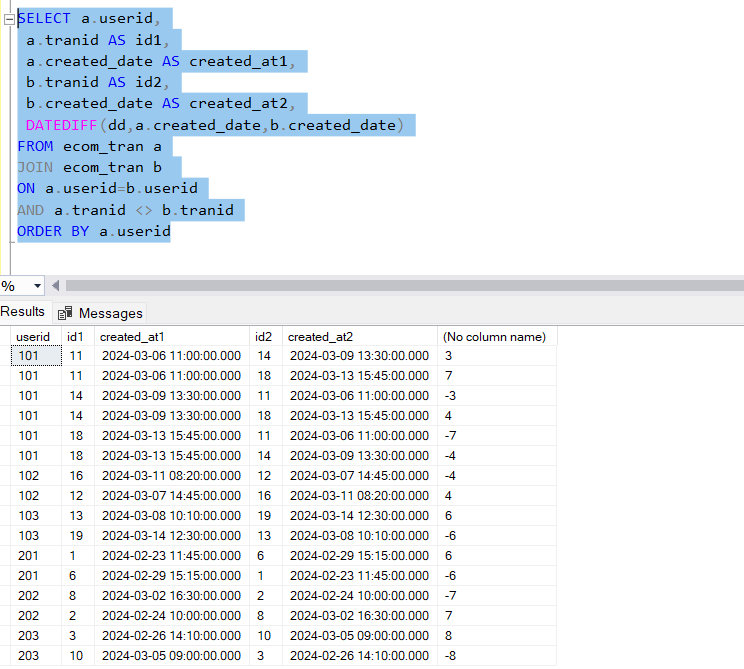
Now if we just filter on the ones where the date difference between the created_dates is > 0 and < 7, that will give us all transcations that happened within 7 days by same user. We can take a distinct value of the userid column to just identify the users that made returning purchases within 7 days.
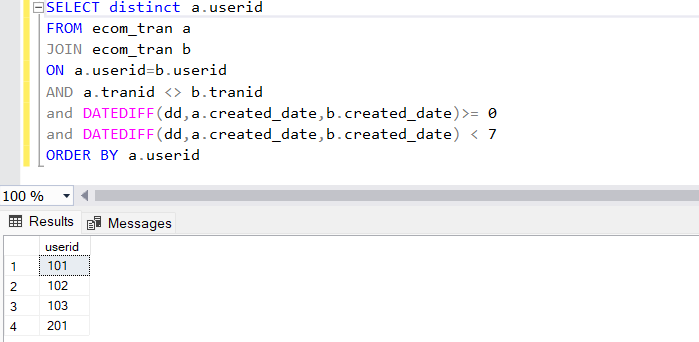
Conclusion:
I hope you got a general understaning and intuition about how the self join performs in SQL. Though self joins are not very intuitive to understand and use, theer are specific use cases where they are indespensible.
I have covered only few of the possible scenarios. Yet, this is sufficient to give you confiedence while facing any SQL interview questions. Even if the question might need intuitive understanding to solve the challenges, these concepts will help to identify what approach to use.
https://medium.com/tag/sqlintermediate
When Do You Self Join? A Handy Trick was originally published in Towards Data Science on Medium, where people are continuing the conversation by highlighting and responding to this story.
Originally appeared here:
When Do You Self Join? A Handy Trick
Go Here to Read this Fast! When Do You Self Join? A Handy Trick